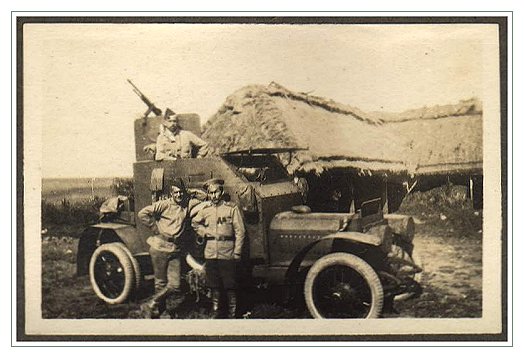|
|
|
|
After the fall of Antwerp in October 1914 and the retreat to the Yser, the front line stabilised and since a breakthough was not forthcoming, there was little use for a highly mobile armoured car force. The Russian military attach to the Belgian armed forces suggested that the armoured car force could be of use on the Eastern Front. Following protocol, Czar Nicholas made an official request to King Albert of the Belgians. It was decided to send a force of several hundred Belgians to Russia. Since Belgium and Russia were co-belligerents and not official allies, for legal reasons the Belgian soldiers were to be considered as volunteers in the Russian army. The Belgian force sailed from Brest on September 22nd 1915 and reached Archangel on October 13, 1915. By way of Petrograd, they were sent to Galicia where they mainly saw action against Austrian forces. The Belgian armoured cars came to be known as effective machine gun destroyers. They continued fighting after the Russian Revolution until the treaty of Brest-Litovsk was signed. The Belgian armoured car force was recalled, but had a difficult time returning home. The trip back to Archangel being unfeasible, the Belgians, much like the Czech Legion, followed the Trans-Siberian railway, crossed northern China and ultimately arrived in Vladivostok. On April 18th, 1918 they boarded an American vessel, the SS Sheridan and sailed to San Francisco. From there they travelled on a much acclaimed and widely publicized trip through the US and sailed from New York on June 15th 1918, finally reaching Paris two weeks later. They were disbanded shortly afterwards. The last member of the Belgian Expeditionary Corps in Russia died in 1992. When they first set sail, the Belgian armoured car force numbered 333 Belgians, all volunteers. In Russia 33 Russians joined its ranks. Counting reinforcements and replacements, 444 Belgians passed through the ranks. There were 58 vehicules of which 12 were armoured cars plus 23 motor-bicycles and 120 bicycles. 16 Belgians were killed in action in Russia. Only one armoured car was lost. It was captured by German forces and is said to have been used in Berlin during the insurrections in 1919. The following photographs are from a private photo album commemorating the death of one of the 16 Belgian casualties. His name was Rena' Rosselt, born in 1888 in Brussels. He was killed in action near Koniouky on July 2nd 1917 and buried two days later in Tarnopol. After the war his remains were repatriated and buried in Brussels in 1921. For further information on Rena' Rosselt, and to see Rena' Rosselt's Photos from his album, "click-on" the link to his web site below. http://www.renarosselt.20m.com |
||
 |
|
|
|
|
 |
|